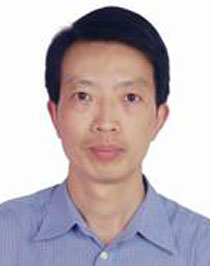
|
Jun TangSubjects: Pharmacognosy Department: School of Pharmaceutical Sciences College appointment: Associate Professor Email: tangj0205@whu.edu.cn Telephone: 86-27-68759315 |
Background/Biography:
Education:
Sep. 2000 - Jun. 2003, Ph.D. student, Department of Pharmacognosy, China Pharmaceutical University;
Oct. 2001 - Sep. 2002, Exchange Ph.D. student, Department of Metabolic Engineering, Institute of Natural Medicine, Toyama Medical and Pharmaceutical University, Japan;
Sep. 1991 - Jul. 1994, Postgraduate, Department of Phytochemistry, Wuhan Institute of Botany, the Chinese Academy of Sciences;
Sep. 1987 - Jul. 1991, Undergraduate, Department of Natural Plant Resources, Jilin Agricultural University.
Professional Experience:
Feb. 2007-Present Associate Professor, School of Pharmaceutical Sciences, Wuhan University, Wuhan, China
Aug. 2009-Mar. 2010 Visiting Scholar/Assistant Professor, Institute of Natural Medicine, University of Toyama, Japan.
Feb. 2006-Jan. 2007 Research Associate, Department of Pharmacology/Department of Chemistry, the University of Hong Kong
Aug. 2004-Feb. 2006 Postdoctoral Research Assistant, School of Chinese Medicine, the University of Hong Kong
Feb. 2004-Jul. 2004 Research Assistant, Department of Pharmacology, the Chinese University of Hong Kong
Teaching:
(1) The courses for undergraduate student: Pharmacognosy, The Experimental Guideline of Pharmacognosy; (2) The courses for postgraduate student: Structure Identification of Organic Compounds, Drug Metabolism and Pharmaceutical Analysis.
Research interests:
Dr. Jun Tang obtained his Ph.D. degree in Pharmacognosy from China Pharmaceutical University in 2003. He had been taking one year in the Institute of Natural Medicine of Toyama Medical and Pharmaceutical University in Japan for his doctoral study under the direction of Professor Masao Hattori. Afterwards, he got several opportunities for postdoctoral training, firstly in Department of Pharmacology of the Chinese University of Hong Kong from Feb. 2004 to Jul. 2004, and then School of Chinese Medicine and Department of Pharmacology in the University of Hong Kong from Aug. 2004 to Jan. 2007. In Feb. 2007, he joined School of Pharmaceutical Sciences, Wuhan University as an Associate Professor. From Aug. 2009 to Mar. 2010, he was invited again to Professor Masao Hattori’s lab as an Assistant Professor in Institute of Natural Medicine, University of Toyama in Japan for some collaborative studies. Since the postgraduation, his research has been involving in the study of Chinese medicines and natural products, especially their chemistry, quality control methodology, efficiency and safety evaluation. His major research interests are natural product chemistry, quality control and standardization of Chinese herbal medicines, biotransformation and toxicology of Chinese medicines by using recently developed techniques in chemistry and pharmacology. He has authored and coauthored over 30 peer-reviewed scientific papers and review articles in English and Chinese in these areas. He has also published a national higher school textbook “Medicine Examination” as the editor-in-chief, and participated in editorial works in another two academic books. His researches are supported by grants from the National Natural Science Foundation of China.
Selected Publications (*Corresponding author):
1.Tang, Jun; Wang, Zheng-tao. Determination of CYP1A2 and CYP2D1 activities in rat liver microsomes and kinetic studies using ultra performance liquid chromatography tandem mass spectrometry. Chinese Pharmaceutical Journal, 2015, 50(12): 1043-1047.
2.Zhou, Zihao; Tang, Jun*; Song, Xueping. Chemical composition of the essential oil of Ligularia hodgsonii and free radical scavenging activity of the oil and crude extracts. Natural Product Communications 2014, 9(10): 1511-1514.
3.He, Ju-xiu; Ohno, Kenji; Tang, Jun; Hattori, Masao; Tani, Tadato; Akao, Teruaki. Da-Chaihu-Tang alters the pharmacokinetics of nifedipine in rats and a treatment regimen to avoid this. Journal of Pharmacy and Pharmacology. 2014, doi: 10.1111/jphp.12285.
4.Tang, Jun*; Wang, Zhengtao; Akao, Teruaki; Hattori, Masao. Further evidence on the intramolecular lactonization in rat liver microsomal metabolism of 12-O-acetylated retronecine-type pyrrolizidine alkaloids. Natural Product Communications 2013, 8(11): 1545-1546.
5.Cheng, Min; Mo, Qigui; Xu, Yun; Tang, Jun*. Quality evaluation of Arnebiae Radix using multiple qualitative and quantitative methods coupled with multivariate statistical analysis. Current Pharmaceutical Analysis, 2013, 9, 217-225.
6.Tang, Jun*; Wang, Zheng-tao; Akao, Teruaki; Hattori, Masao. Human intestinal bacteria mediate reduction of the N-oxides of isoline and monocrotaline to the corresponding parent alkaloids. Asian Journal of Chemistry 2013, 25(4), 2027-2030.
7.Tang, Jun*; Cheng, Min; Hattori, Masao. Pyrrolizidine alkaloid profile in a traditional Chinese herbal medicine Chuan Zi Wan (Ligulariae Radix et Rhizoma) by liquid chromatography/electrospray ionization ion trap mass spectrometry. Analytical Methods 2012, 4: 2797-2808.
8.Tang, Jun*; Hattori, Masao. Pyrrolizidine alkaloids-containing Chinese medicines in the Chinese Pharmacopoeia and related safety concerns. Acta Pharmaceutica Sinica 2011, 46, 762-772
9.Tang, Jun; Feng, Yibin; Tsao, Saiwah; Wang, Ning; Curtain, Robert; Wang, Youwei. Berberine and Coptidis Rhizoma as novel antineoplastic agents: A review of traditional use and biomedical investigations. Journal of Ethnopharmacology 2009, 126 (1): 5-17. (ESI highly cited paper)
10.Tang, Jun; Feng, Yibin; Tong, Yao; Yap Madeline, Man YK. A distinct new microscopic feature for the identification of the crude drug of Radix Angelicae Pubescentis. Journal of Chinese Medicinal Materials. 2008, 31(12):1796-1802.
11.Tang, Jun; Akao, Teruaki; Nakamura, Norio; Wang, Zheng-tao; Takagawa, Kiyoshi; Sasahara, Masakiyo; Hattori, Masao. In vitro metabolism of isoline, a pyrrolizidine alkaloid from Ligularia duciformis, by rodent liver microsomal esterase and enhanced hepatotoxicity by esterase inhibitors. Drug Metabolism and Disposition 2007, 35: 1832-1839.